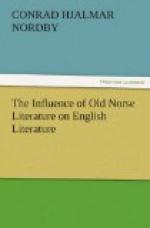More valuable than the poetry is the prose of this literature, especially the Sagas. The saga is a prose epic, characteristic of the Norse countries. It records the life of a hero, told according to fixed rules. As we have said, the sagas were based upon careers run in Iceland’s stormy time. They are both mythical and historical. In the mythical group are, among others, the Voelsunga Saga, the Hervarar Saga, Frieththjofs Saga and Ragnar Loethbroks Saga. In the historical group, the flowering time of which was 1200-1270, we find, for example, Egils Saga, Eyrbyggja Saga, Laxdaela Saga, Grettis Saga, Njals Saga. A branch of the historic sagas is the Kings’ Sagas, in which we find Heimskringla, the Saga of Olaf Tryggvason, the Flatey Book, and others.
This sketch does not pretend to indicate the quantity of Old Norse literature. An idea of that is obtained by considering the fact that eleven columns of the ninth edition of the Encyclopaedia Britannica are devoted to recording the works of that body of writings.
II.
THROUGH THE MEDIUM OF LATIN.
THOMAS GRAY (1716-1771).
In the eighteenth century, Old Norse literature was the lore of antiquarians. That it is not so to-day among English readers is due to a line of writers, first of whom was Thomas Gray. In the thin volume of his poetry, two pieces bear the sub-title: “An Ode. From the Norse Tongue.” These are “The Fatal Sisters,” and “The Descent of Odin,” both written in 1761, though not published until 1768. These poems are among the latest that Gray gave to the world, and are interesting aside from our present purpose because they mark the limit of Gray’s progress toward Romanticism.
We are not accustomed to think of Gray as a Romantic poet, although we know well that the movement away from the so-called Classicism was begun long before he died. The Romantic element in his poetry is not obvious; only the close observer detects it, and then only in a few of the poems. The Pindaric odes exhibit a treatment that is Romantic, and the Norse and Welsh adaptations are on subjects that are Romantic. But we must go to his letters to find proof positive of his sympathy with the breaking away from Classicism. Here are records of a love of outdoors that reveled in mountain-climbing and the buffeting of storms. Here are appreciations of Shakespeare and of Milton, the like of which were not often proclaimed in his generation. Here is ecstatic admiration of ballads and of the Ossian imitations, all so unfashionable in the literary culture of the day. While dates disprove Lowell’s statement in his essay on Gray that “those anti-classical yearnings of Gray began after he had ceased producing,” it is certain that very little of his poetic work expressed these yearnings. “Elegance, sweetness, pathos, or even majesty he could achieve, but never that force which vibrates in every verse of larger moulded men.” Change Lowell’s word “could” to “did,” and this sentence will serve our purpose here.




